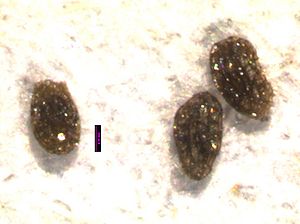Difference between revisions of "Aphyllon purpureum"
| Line 52: | Line 52: | ||
==The Seeds== | ==The Seeds== | ||
[[File:Orobanche uniflora.jpg|thumb|300px|''Orobanche uniflora'' Photo credit Lisa Hintz]] | [[File:Orobanche uniflora.jpg|thumb|300px|''Orobanche uniflora'' Photo credit Lisa Hintz]] | ||
| + | Orobanche uniflora | ||
| + | |||
| + | ORUN | ||
| + | Seed sample from 2011 | ||
| + | |||
| + | Average Measurement: 0.2 x 0.1 x 0.1 | ||
| + | |||
| + | Measurement Range: L: 0.1 – 0.3, W: 0.1 – 0.2, D: 0.1 – 0.2 | ||
| + | |||
| + | Latitudinal Cross Section: elliptical [[File:Lat cs.png]] | ||
| + | |||
| + | Longitudinal Cross Section: elliptical | ||
| + | |||
| + | Shape: Seed very small, slightly narrower at hilum and opposite apex. Seed generally egg shaped, some specimens more slender than others. | ||
| + | |||
| + | Color: Most seeds brown, some tan. | ||
| + | |||
| + | Surface: Seed coat deeply honeycombed, and somewhat iridescent. | ||
{{Basics}} | {{Basics}} | ||
Revision as of 10:44, 7 May 2012
Orobanche uniflora is a flowering plant in the Orobanchaceae family. Also called naked broomrape, one flowered broomrape, or cancer root, O. uniflora is a parasitic plant.
Synonyms:Aphyllon uniflorum, Orobanche uniflora var. typica, Orobanche uniflora var. terrae-novae, Orobanche uniflora var. sedii, Orobanche uniflora var. purpurea, Orobanche uniflora var. occidentalis, Orobanche terrae-novae, Orobanche sedii, Orobanche purpurea, Orobanche porphyrantha, Thalesia uniflora, Orobanche uniflora var. minuta, Orobanche uniflora ssp. occidentalis, Orobanche uniflora var. sedi
Source: http://www.calflora.org/cgi-bin/species_query.cgi?where-taxon=Orobanche+uniflora
Contents
Taxonomy
- Kingdom Plantae – Plants
- Subkingdom -Tracheobionta – Vascular plants
- Superdivision - Spermatophyta – Seed plants
- Division - Magnoliophyta – Flowering plants
- Class - Magnoliopsida – Dicotyledons
- Subclass - Asteridae
- Order - Scrophulariales
- Family - Orobanchaceae – Broom-rape family
- Genus - Orobanche – broomrape
- Species - O. uniflora
Description
O. uniflora is a short, annual, parasitic herb that is glandular hairy. It is somewhat fleshy. The stems of this plant are short (1 - 5 cm) compared to the pedicles, which are 3 - 10 cm long. The herb has no leaves or bracts. Flowers 1 - 3, on long pedicles. Calyx 5 -12 mm, with brown to purple corolla that measures 15 - 35 mm. Flower two lipped, with five finely fringed lobes.
http://biology.burke.washington.edu/herbarium/imagecollection.php
Bloom Period
April to August http://biology.burke.washington.edu/herbarium/imagecollection.php
Distribution
Present in every contiguous state in the United States, plus Alaska and much of Canada.
Source: http://plants.usda.gov/java/profile?symbol=ORUN
Habitat
Moist open sites, or open woods. Low to middle elevations.
Uses
Propagation
Photo Gallery
http://biology.burke.washington.edu/herbarium/imagecollection.php
References
The Seeds
Orobanche uniflora
ORUN
Seed sample from 2011
Average Measurement: 0.2 x 0.1 x 0.1
Measurement Range: L: 0.1 – 0.3, W: 0.1 – 0.2, D: 0.1 – 0.2
Latitudinal Cross Section: elliptical ![]()
Longitudinal Cross Section: elliptical
Shape: Seed very small, slightly narrower at hilum and opposite apex. Seed generally egg shaped, some specimens more slender than others.
Color: Most seeds brown, some tan.
Surface: Seed coat deeply honeycombed, and somewhat iridescent.
Basic Explanations and Assumptions:
The dimensions for the seeds are length x width x depth. The location of the hilum is used as the base of the seed, and the length is measured from hilum to the opposite apex. Where a style is present, the length is measured from the hilum to the bottom of the style. Width is measured at a right angle to the length at the widest part. Depth is measured at a right angle to the intersection of height and width lines.
Measurements included are the mean average for each measurement of ten separate seeds.
All measurements in millimeters unless otherwise noted.

